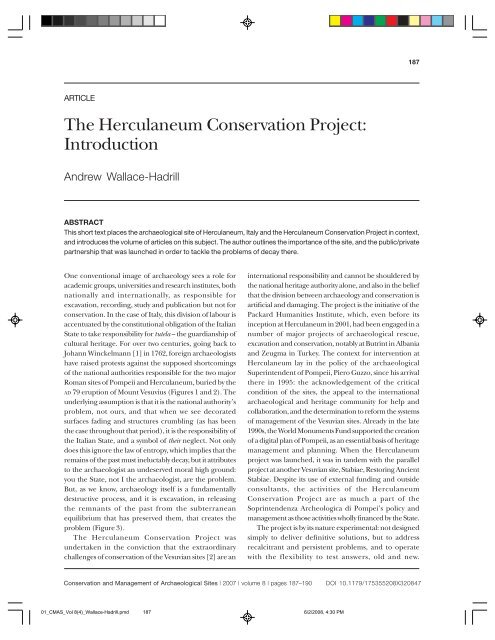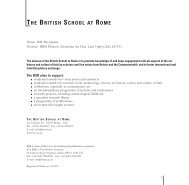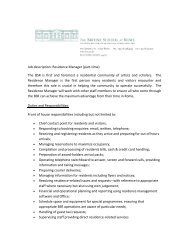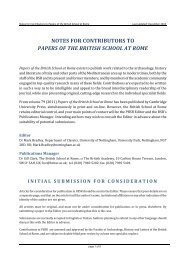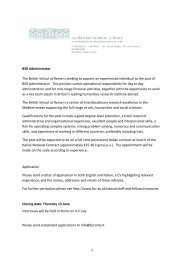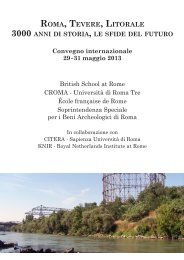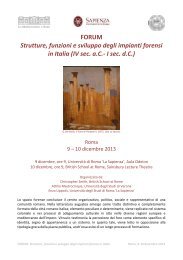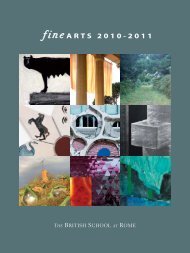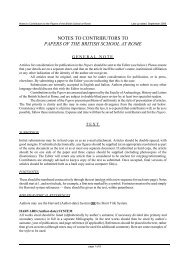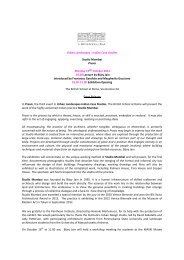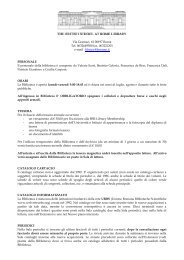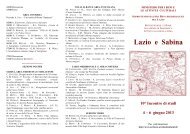an introduction - The British School at Rome
an introduction - The British School at Rome
an introduction - The British School at Rome
You also want an ePaper? Increase the reach of your titles
YUMPU automatically turns print PDFs into web optimized ePapers that Google loves.
CONSERVATION OF THE SACRED AT ANGKOR WAT: FURTHER REFLECTIONS ON LIVING HERITAGE 187<br />
ARTICLE<br />
<strong>The</strong> Hercul<strong>an</strong>eum Conserv<strong>at</strong>ion Project:<br />
Introduction<br />
Andrew Wallace-Hadrill<br />
ABSTRACT<br />
This short text places the archaeological site of Hercul<strong>an</strong>eum, Italy <strong>an</strong>d the Hercul<strong>an</strong>eum Conserv<strong>at</strong>ion Project in context,<br />
<strong>an</strong>d introduces the volume of articles on this subject. <strong>The</strong> author outlines the import<strong>an</strong>ce of the site, <strong>an</strong>d the public/priv<strong>at</strong>e<br />
partnership th<strong>at</strong> was launched in order to tackle the problems of decay there.<br />
One conventional image of archaeology sees a role for<br />
academic groups, universities <strong>an</strong>d research institutes, both<br />
n<strong>at</strong>ionally <strong>an</strong>d intern<strong>at</strong>ionally, as responsible for<br />
excav<strong>at</strong>ion, recording, study <strong>an</strong>d public<strong>at</strong>ion but not for<br />
conserv<strong>at</strong>ion. In the case of Italy, this division of labour is<br />
accentu<strong>at</strong>ed by the constitutional oblig<strong>at</strong>ion of the Itali<strong>an</strong><br />
St<strong>at</strong>e to take responsibility for tutela – the guardi<strong>an</strong>ship of<br />
cultural heritage. For over two centuries, going back to<br />
Joh<strong>an</strong>n Winckelm<strong>an</strong>n [1] in 1762, foreign archaeologists<br />
have raised protests against the supposed shortcomings<br />
of the n<strong>at</strong>ional authorities responsible for the two major<br />
Rom<strong>an</strong> sites of Pompeii <strong>an</strong>d Hercul<strong>an</strong>eum, buried by the<br />
AD 79 eruption of Mount Vesuvius (Figures 1 <strong>an</strong>d 2). <strong>The</strong><br />
underlying assumption is th<strong>at</strong> it is the n<strong>at</strong>ional authority’s<br />
problem, not ours, <strong>an</strong>d th<strong>at</strong> when we see decor<strong>at</strong>ed<br />
surfaces fading <strong>an</strong>d structures crumbling (as has been<br />
the case throughout th<strong>at</strong> period), it is the responsibility of<br />
the Itali<strong>an</strong> St<strong>at</strong>e, <strong>an</strong>d a symbol of their neglect. Not only<br />
does this ignore the law of entropy, which implies th<strong>at</strong> the<br />
remains of the past must ineluctably decay, but it <strong>at</strong>tributes<br />
to the archaeologist <strong>an</strong> undeserved moral high ground:<br />
you the St<strong>at</strong>e, not I the archaeologist, are the problem.<br />
But, as we know, archaeology itself is a fundamentally<br />
destructive process, <strong>an</strong>d it is excav<strong>at</strong>ion, in releasing<br />
the remn<strong>an</strong>ts of the past from the subterr<strong>an</strong>e<strong>an</strong><br />
equilibrium th<strong>at</strong> has preserved them, th<strong>at</strong> cre<strong>at</strong>es the<br />
problem (Figure 3).<br />
<strong>The</strong> Hercul<strong>an</strong>eum Conserv<strong>at</strong>ion Project was<br />
undertaken in the conviction th<strong>at</strong> the extraordinary<br />
challenges of conserv<strong>at</strong>ion of the Vesuvi<strong>an</strong> sites [2] are <strong>an</strong><br />
intern<strong>at</strong>ional responsibility <strong>an</strong>d c<strong>an</strong>not be shouldered by<br />
the n<strong>at</strong>ional heritage authority alone, <strong>an</strong>d also in the belief<br />
th<strong>at</strong> the division between archaeology <strong>an</strong>d conserv<strong>at</strong>ion is<br />
artificial <strong>an</strong>d damaging. <strong>The</strong> project is the initi<strong>at</strong>ive of the<br />
Packard Hum<strong>an</strong>ities Institute, which, even before its<br />
inception <strong>at</strong> Hercul<strong>an</strong>eum in 2001, had been engaged in a<br />
number of major projects of archaeological rescue,<br />
excav<strong>at</strong>ion <strong>an</strong>d conserv<strong>at</strong>ion, notably <strong>at</strong> Butrint in Alb<strong>an</strong>ia<br />
<strong>an</strong>d Zeugma in Turkey. <strong>The</strong> context for intervention <strong>at</strong><br />
Hercul<strong>an</strong>eum lay in the policy of the archaeological<br />
Superintendent of Pompeii, Piero Guzzo, since his arrival<br />
there in 1995: the acknowledgement of the critical<br />
condition of the sites, the appeal to the intern<strong>at</strong>ional<br />
archaeological <strong>an</strong>d heritage community for help <strong>an</strong>d<br />
collabor<strong>at</strong>ion, <strong>an</strong>d the determin<strong>at</strong>ion to reform the systems<br />
of m<strong>an</strong>agement of the Vesuvi<strong>an</strong> sites. Already in the l<strong>at</strong>e<br />
1990s, the World Monuments Fund supported the cre<strong>at</strong>ion<br />
of a digital pl<strong>an</strong> of Pompeii, as <strong>an</strong> essential basis of heritage<br />
m<strong>an</strong>agement <strong>an</strong>d pl<strong>an</strong>ning. When the Hercul<strong>an</strong>eum<br />
project was launched, it was in t<strong>an</strong>dem with the parallel<br />
project <strong>at</strong> <strong>an</strong>other Vesuvi<strong>an</strong> site, Stabiae, Restoring Ancient<br />
Stabiae. Despite its use of external funding <strong>an</strong>d outside<br />
consult<strong>an</strong>ts, the activities of the Hercul<strong>an</strong>eum<br />
Conserv<strong>at</strong>ion Project are as much a part of the<br />
Soprintendenza Archeologica di Pompei’s policy <strong>an</strong>d<br />
m<strong>an</strong>agement as those activities wholly fin<strong>an</strong>ced by the St<strong>at</strong>e.<br />
<strong>The</strong> project is by its n<strong>at</strong>ure experimental: not designed<br />
simply to deliver definitive solutions, but to address<br />
recalcitr<strong>an</strong>t <strong>an</strong>d persistent problems, <strong>an</strong>d to oper<strong>at</strong>e<br />
with the flexibility to test <strong>an</strong>swers, old <strong>an</strong>d new.<br />
Conserv<strong>at</strong>ion <strong>an</strong>d M<strong>an</strong>agement of Archaeological Sites | 2007 | volume 8 | pages 187–190<br />
DOI 10.1179/175355208X320847<br />
01_CMAS_Vol 8(4)_Wallace-Hadrill.pmd<br />
187<br />
6/2/2008, 4:30 PM
188 Andrew Wallace-Hadrill<br />
Figure 1. Map of the Vesuvi<strong>an</strong> area showing Hercul<strong>an</strong>eum in its<br />
context. Reproduced with permission from Ines Maddaloni/HCP.<br />
Figure 3. <strong>The</strong> main excav<strong>at</strong>ed area of the archaeological site of<br />
Hercul<strong>an</strong>eum, with its phases of excav<strong>at</strong>ion. 1: excav<strong>at</strong>ions 1828–1875;<br />
2: excav<strong>at</strong>ions 1927–1958; 3: excav<strong>at</strong>ions 1960–1969; 4: excav<strong>at</strong>ions<br />
1980–1994. Reproduced with permission from Ines Maddaloni/HCP.<br />
Figure 2. <strong>The</strong> archaeological site of Hercul<strong>an</strong>eum in its urb<strong>an</strong> context,<br />
surrounded by the modern city of Ercol<strong>an</strong>o on the lower slopes of<br />
Mount Vesuvius. Reproduced with permission from K<strong>at</strong>e Cook/Firefly.<br />
Fundamental to th<strong>at</strong> flexibility is the freedom enjoyed<br />
by a priv<strong>at</strong>e sponsor to oper<strong>at</strong>e outside the straitjacket<br />
of the legisl<strong>at</strong>ive restrictions <strong>an</strong>d bureaucr<strong>at</strong>ic practices<br />
th<strong>at</strong> make fresh approaches <strong>an</strong>d new thinking so difficult<br />
within the St<strong>at</strong>e system [3]. Even the setting up of the<br />
legal framework to enable this to become possible took<br />
the first four years of the project: it was th<strong>an</strong>ks to the<br />
perception of our legal consult<strong>an</strong>t, supported <strong>at</strong> the<br />
highest level by the legal office of the Ministry of Culture,<br />
th<strong>at</strong> the newly passed law [3] to promote cultural<br />
sponsorship could be used to cre<strong>at</strong>e a suitable framework<br />
for undertaking building work <strong>at</strong> priv<strong>at</strong>e expense, <strong>an</strong>d<br />
under priv<strong>at</strong>e m<strong>an</strong>agement [4], on a public monument.<br />
At the same time, as David W. Packard, president of<br />
the Packard Hum<strong>an</strong>ities Institute, rightly insists, there is a<br />
risk th<strong>at</strong> a short-term injection of priv<strong>at</strong>e funding may<br />
prove a ‘resource curse’ unless carefully directed to<br />
achieving a solution capable of enduring beyond its own<br />
end. Neither party to the collabor<strong>at</strong>ion, the Packard<br />
Hum<strong>an</strong>ities Institute as sponsor, <strong>an</strong>d the Soprintendenza,<br />
aspires to resolving for ever the problems of the site.<br />
R<strong>at</strong>her, the project aims to address the immedi<strong>at</strong>e<br />
situ<strong>at</strong>ions of emergency <strong>an</strong>d, especially, the infrastructural<br />
problems of w<strong>at</strong>er-m<strong>an</strong>agement, access <strong>an</strong>d roofing, to<br />
underst<strong>an</strong>d better through experiment <strong>an</strong>d testing the<br />
root causes of decay, <strong>an</strong>d to try out <strong>an</strong>d put in place<br />
models of continuous care which have the best ch<strong>an</strong>ce of<br />
slowing down the r<strong>at</strong>e of decay into the future [5, 6].<br />
<strong>The</strong> project is not limited in its aims to conserv<strong>at</strong>ion. It<br />
also aspires to cre<strong>at</strong>e new archaeological knowledge of<br />
the site, <strong>an</strong>d to extend the appreci<strong>at</strong>ion of the site among<br />
the professional communities <strong>an</strong>d the general public. <strong>The</strong><br />
key to success lies in the cre<strong>at</strong>ion of a multidisciplinary<br />
Conserv<strong>at</strong>ion <strong>an</strong>d M<strong>an</strong>agement of Archaeological Sites | 2007 | volume 8 | pages 187–190<br />
01_CMAS_Vol 8(4)_Wallace-Hadrill.pmd<br />
188<br />
6/2/2008, 4:30 PM
THE HERCULANEUM CONSERVATION PROJECT: INTRODUCTION<br />
189<br />
team, of archaeologists, conserv<strong>at</strong>or-restorers, architects,<br />
engineers, scientists, surveyors <strong>an</strong>d IT specialists, under<br />
the orchestr<strong>at</strong>ion of a project m<strong>an</strong>ager. Hence, <strong>at</strong> every<br />
stage, archaeological investig<strong>at</strong>ion has underpinned<br />
conserv<strong>at</strong>ion work. It rapidly emerged th<strong>at</strong> we were not<br />
simply dealing with a fragment of the Rom<strong>an</strong> past, but<br />
one carefully recomposed by its main excav<strong>at</strong>or, Amedeo<br />
Maiuri, <strong>an</strong>d th<strong>at</strong> thorough underst<strong>an</strong>ding was needed<br />
both of the precise processes by which he had excav<strong>at</strong>ed<br />
<strong>an</strong>d reconstructed each building, <strong>an</strong>d of his own vision of<br />
public present<strong>at</strong>ion <strong>an</strong>d conserv<strong>at</strong>ion of the site [7]. <strong>The</strong><br />
loss of the tr<strong>an</strong>smitted knowledge of the workforce set up<br />
by Maiuri is one of the fundamental causes of acceler<strong>at</strong>ed<br />
decay on the site. At the same time, it has emerged how<br />
closely archaeological investig<strong>at</strong>ion <strong>an</strong>d conserv<strong>at</strong>ion go<br />
h<strong>an</strong>d in h<strong>an</strong>d. <strong>The</strong> need to address the overriding problem<br />
of w<strong>at</strong>er m<strong>an</strong>agement led to the reopening of the vast<br />
Rom<strong>an</strong> sewers th<strong>at</strong> run under the Insula Orientalis II<br />
area of the site; renewed excav<strong>at</strong>ion there has gener<strong>at</strong>ed<br />
a massive new d<strong>at</strong>aset of household refuse <strong>an</strong>d org<strong>an</strong>ic<br />
m<strong>at</strong>erials th<strong>at</strong> c<strong>an</strong> cast signific<strong>an</strong>t light on the economic<br />
<strong>an</strong>d social life of the inhabit<strong>an</strong>ts of this multi-storey<br />
complex [8].<br />
<strong>The</strong> advice of our engineers <strong>an</strong>d architects led to a<br />
focus on the problems of the precipitous edge of the site,<br />
d<strong>an</strong>gerously steep in profile, heavily overgrown with<br />
veget<strong>at</strong>ion, <strong>an</strong>d putting <strong>at</strong> risk not only the <strong>an</strong>cient<br />
structures below but the modern properties situ<strong>at</strong>ed<br />
perilously close to the edge of the excav<strong>at</strong>ions. <strong>The</strong><br />
development of a dialogue between all interested parties,<br />
especially the Comune di Ercol<strong>an</strong>o, the local city authorities,<br />
whose area of responsibility seems to drop off as abruptly<br />
as the edge of the site itself, made possible a new campaign<br />
of demolition <strong>an</strong>d clear<strong>an</strong>ce <strong>at</strong> the north-western corner<br />
of the site. <strong>The</strong> fact th<strong>at</strong> this corner overlies the public<br />
buildings <strong>at</strong> the heart of the <strong>an</strong>cient city cre<strong>at</strong>es <strong>at</strong> least the<br />
future prospect of making better sense of a site whose<br />
present limits end abruptly <strong>at</strong> its most interesting point.<br />
Artefacts, too, form <strong>an</strong> integral part of the m<strong>at</strong>erial<br />
record of <strong>an</strong> <strong>an</strong>cient city. Those of Hercul<strong>an</strong>eum are<br />
unusually rich, th<strong>an</strong>ks both to the exceptional preserv<strong>at</strong>ion<br />
of wood <strong>an</strong>d other org<strong>an</strong>ic m<strong>at</strong>erials, <strong>an</strong>d to the fact th<strong>at</strong><br />
the volc<strong>an</strong>ic overburden protected the city from the<br />
system<strong>at</strong>ic looting to which Pompeii was subjected in<br />
<strong>an</strong>tiquity. But by a double irony of f<strong>at</strong>e, these finds were<br />
never published, since Maiuri died before writing the<br />
volume th<strong>at</strong> was to have been dedic<strong>at</strong>ed to them <strong>an</strong>d,<br />
although Maiuri went to exceptional pains to make the<br />
objects visible to the public by displaying them in the shops<br />
<strong>an</strong>d houses where they were found, for the last 30 years<br />
they have been invisible in the purpose-built Antiquarium<br />
on-site which has, since its construction, never been<br />
completed <strong>an</strong>d opened to the public. <strong>The</strong> current project<br />
has produced a new c<strong>at</strong>alogue of all these objects, <strong>an</strong>d is<br />
working with the Soprintendenza to ensure the opening of<br />
the Antiquarium.<br />
A final aim of the project lies in the emphasis placed on<br />
public inclusion. In the end, no site will survive unless both<br />
the outside visitors <strong>an</strong>d the local popul<strong>at</strong>ion appreci<strong>at</strong>e<br />
<strong>an</strong>d treasure it. <strong>The</strong> final part of Amedeo Maiuri’s legacy<br />
th<strong>at</strong> the project aims to revitalise is the Intern<strong>at</strong>ional Centre<br />
for the Study of Hercul<strong>an</strong>eum, based in the nearby Villa<br />
Ravone, which is commonly known as the Villa Maiuri after<br />
the study centre th<strong>at</strong> he set up. Th<strong>an</strong>ks to <strong>an</strong> agreement<br />
between the Soprintendenza <strong>an</strong>d the Comune di Ercol<strong>an</strong>o,<br />
<strong>an</strong> Associ<strong>at</strong>ion has been formed [9] <strong>an</strong>d a three-year<br />
programme launched, fin<strong>an</strong>ced by a gr<strong>an</strong>t of public funds,<br />
to adv<strong>an</strong>ce the knowledge of Hercul<strong>an</strong>eum <strong>at</strong> both <strong>an</strong><br />
intern<strong>at</strong>ional <strong>an</strong>d a local level. In collabor<strong>at</strong>ion with the<br />
Intern<strong>at</strong>ional Centre for the Study of the Preserv<strong>at</strong>ion <strong>an</strong>d<br />
Restor<strong>at</strong>ion of Cultural Property (ICCROM), a signific<strong>an</strong>t<br />
part of its mid-career training course in 2007 on the<br />
Conserv<strong>at</strong>ion of Built Heritage demonstr<strong>at</strong>ed wh<strong>at</strong> a rich<br />
case study Hercul<strong>an</strong>eum could offer to a group of<br />
conserv<strong>at</strong>ion specialists from 22 countries, <strong>an</strong>d wh<strong>at</strong> a<br />
positive contribution th<strong>at</strong> intern<strong>at</strong>ional community could<br />
bring to reuniting the <strong>an</strong>cient <strong>an</strong>d modern cities.<br />
<strong>The</strong> following articles illustr<strong>at</strong>e in more detail some<br />
chosen aspects of the project. Wh<strong>at</strong> should be underlined<br />
here is the fundamental import<strong>an</strong>ce of the close<br />
collabor<strong>at</strong>ion between members of the project team <strong>an</strong>d<br />
members of the Soprintendenza staff, directed by the Site<br />
Director, Maria Paola Guidobaldi. <strong>The</strong> project is overseen<br />
by a Scientific Committee th<strong>at</strong> combines the expertise of<br />
the Superintendent, Piero Guzzo, <strong>an</strong>d colleagues in the<br />
Itali<strong>an</strong> St<strong>at</strong>e system with intern<strong>at</strong>ional experts in<br />
archaeology <strong>an</strong>d conserv<strong>at</strong>ion. All share the vision of David<br />
W. Packard, th<strong>at</strong> Hercul<strong>an</strong>eum is a uniquely precious site<br />
th<strong>at</strong> deserves to be preserved for future gener<strong>at</strong>ions, <strong>an</strong>d<br />
th<strong>at</strong> c<strong>an</strong> be preserved if we work together.<br />
◗ Andrew Wallace-Hadrill has directed the<br />
Hercul<strong>an</strong>eum Conserv<strong>at</strong>ion Project since it beg<strong>an</strong><br />
in 2001. He is Professor of Classics <strong>at</strong> Reading<br />
University (1987-) <strong>an</strong>d since 1995 he has been Director<br />
of the <strong>British</strong> <strong>School</strong> <strong>at</strong> <strong>Rome</strong>. He has published<br />
Conserv<strong>at</strong>ion <strong>an</strong>d M<strong>an</strong>agement of Archaeological Sites | 2007 | volume 8 | pages 187–190<br />
01_CMAS_Vol 8(4)_Wallace-Hadrill.pmd<br />
189<br />
6/2/2008, 4:30 PM
190 Andrew Wallace-Hadrill<br />
papers on a wide r<strong>an</strong>ge of Rom<strong>an</strong> themes.<br />
Contact details: <strong>British</strong> <strong>School</strong> <strong>at</strong> <strong>Rome</strong>, Via Gramsci<br />
61, 00197 Roma, Italy. Email: director@bsrome.it<br />
REFERENCES<br />
1. Germ<strong>an</strong> archaeologist <strong>an</strong>d histori<strong>an</strong> of <strong>an</strong>cient art<br />
(1717–1768).<br />
2. On 1 April 2008 the heritage authority responsible for<br />
the Vesuvi<strong>an</strong> archaeological sites – including<br />
Hercul<strong>an</strong>eum – merged with th<strong>at</strong> of Naples, leading to<br />
the cre<strong>at</strong>ion of the Soprintendenza Speciale per i Beni<br />
Archaeologici di Napoli e Pompei. This occurred as this<br />
special edition of articles on Hercul<strong>an</strong>eum went to<br />
print, so readers will note th<strong>at</strong> all the authors instead<br />
make reference to the Soprintendenza Archeologica di<br />
Pompei, which <strong>at</strong> the time of writing was responsible for<br />
archaeology around Mount Vesuvius including several<br />
import<strong>an</strong>t sites destroyed by the volc<strong>an</strong>ic eruption of<br />
AD 79 including Pompeii, Hercul<strong>an</strong>eum, Stabiae,<br />
Oplontis <strong>an</strong>d Boscoreale (which includes a museum).<br />
<strong>The</strong> 1997 UNESCO inscription of Pompeii,<br />
Hercul<strong>an</strong>eum <strong>an</strong>d Torre Annunzi<strong>at</strong>a (Oplontis) on the<br />
World Heritage List defined them as follows: ‘<strong>The</strong><br />
towns of Pompeii <strong>an</strong>d Hercul<strong>an</strong>eum <strong>an</strong>d their<br />
associ<strong>at</strong>ed villas provide a complete <strong>an</strong>d vivid picture of<br />
society <strong>an</strong>d daily life <strong>at</strong> a specific moment in the past<br />
th<strong>at</strong> is without parallel <strong>an</strong>ywhere in the world.’<br />
3. Thompson, J. Conserv<strong>at</strong>ion <strong>an</strong>d m<strong>an</strong>agement<br />
challenges in a public/priv<strong>at</strong>e initi<strong>at</strong>ive for a large<br />
archaeological site (Hercul<strong>an</strong>eum, Italy).<br />
Conserv<strong>at</strong>ion <strong>an</strong>d M<strong>an</strong>agement of Archaeological Sites,<br />
this volume (2007) 191–204.<br />
4. A third org<strong>an</strong>is<strong>at</strong>ion, the <strong>British</strong> <strong>School</strong> <strong>at</strong> <strong>Rome</strong>,<br />
joined the partnership <strong>at</strong> this stage to strengthen<br />
oper<strong>at</strong>ional capacity. For further inform<strong>at</strong>ion on the<br />
project please contact hcp@hercul<strong>an</strong>eum.org. For<br />
further inform<strong>at</strong>ion on the three project partners<br />
see their own websites: Soprintendenza<br />
Archeologica di Pompei www.pompeiisites.org;<br />
Packard Hum<strong>an</strong>ities Institute www.packhum.org;<br />
<strong>British</strong> <strong>School</strong> <strong>at</strong> <strong>Rome</strong> www.bsr.ac.uk.<br />
5. Pesaresi, P. <strong>an</strong>d Martelli Castaldi, M. Conserv<strong>at</strong>ion<br />
measures for <strong>an</strong> archaeological site <strong>at</strong> risk<br />
(Hercul<strong>an</strong>eum, Italy): from emergency to<br />
mainten<strong>an</strong>ce. Conserv<strong>at</strong>ion <strong>an</strong>d M<strong>an</strong>agement of<br />
Archaeological Sites, this volume (2007) 215–236.<br />
6. Pesaresi, P. <strong>an</strong>d Rizzi, G. New <strong>an</strong>d existing forms of<br />
protective shelter <strong>at</strong> Hercul<strong>an</strong>eum: towards<br />
improving the continuous care of the site.<br />
Conserv<strong>at</strong>ion <strong>an</strong>d M<strong>an</strong>agement of Archaeological Sites,<br />
this volume (2007) 237–252.<br />
7. Camardo, D. Archaeology <strong>an</strong>d conserv<strong>at</strong>ion <strong>at</strong><br />
Hercul<strong>an</strong>eum: from the Maiuri campaign to the<br />
Hercul<strong>an</strong>eum Conserv<strong>at</strong>ion Project. Conserv<strong>at</strong>ion<br />
<strong>an</strong>d M<strong>an</strong>agement of Archaeological Sites, this volume<br />
(2007) 205–214.<br />
8. Camardo, D. Lo scavo della fogna dell’Insula Orientalis<br />
II. In: P.G. Guzzo <strong>an</strong>d M.P. Guidobaldi (eds) Atti del<br />
convegno internazionale sulle Nuove ricerche<br />
archeologiche nell’area vesuvi<strong>an</strong>a (scavi 2003–2006),<br />
<strong>Rome</strong>, 1–3 February (2007). Electa, Naples<br />
(forthcoming).<br />
9. <strong>The</strong> local heritage authority, the Soprintendenza<br />
Archeologica di Pompei, <strong>an</strong>d the local city council, the<br />
Comune di Ercol<strong>an</strong>o, are the founding<br />
members of the ‘Associazione Hercul<strong>an</strong>eum’ but were<br />
soon joined by a third partner, the <strong>British</strong> <strong>School</strong> <strong>at</strong><br />
<strong>Rome</strong>, which has offered a strong link to the activities<br />
of the Hercul<strong>an</strong>eum Conserv<strong>at</strong>ion Project.<br />
● Le Projet de Conserv<strong>at</strong>ion Hercul<strong>an</strong>um:<br />
Introduction<br />
Andrew Wallace-Hadrill<br />
RÉSUMÉ<br />
Ce bref article offre un aperçu du site archéologique<br />
d’Hercul<strong>an</strong>um, en Italie, et place le Projet de<br />
Conserv<strong>at</strong>ion Hercul<strong>an</strong>um d<strong>an</strong>s son contexte. Le texte<br />
sert également d’<strong>introduction</strong> aux articles de ce volume<br />
sur le même sujet. L’auteur y souligne l’import<strong>an</strong>ce du<br />
site, et du partenari<strong>at</strong> public/privé qui a été l<strong>an</strong>cé afin de<br />
faire face aux problèmes de dégrad<strong>at</strong>ion sur le site.<br />
● El Proyecto de Conservación Hercul<strong>an</strong>o:<br />
Introducción<br />
Andrew Wallace-Hadrill<br />
RESUMEN<br />
Este breve artículo coloca al sitio arqueológico de<br />
Hercul<strong>an</strong>o y al Proyecto de Conservación Hercul<strong>an</strong>o<br />
en contexto. El texto sirve también como introducción<br />
para los artículos en este volumen que tr<strong>at</strong><strong>an</strong> de este<br />
tema. El autor subraya la import<strong>an</strong>cia del sitio, y de la<br />
asociación pública/privada que se l<strong>an</strong>zó con el fin de<br />
hacer frente a los problemas de degradación en el sitio.<br />
Conserv<strong>at</strong>ion <strong>an</strong>d M<strong>an</strong>agement of Archaeological Sites | 2007 | volume 8 | pages 187–190<br />
01_CMAS_Vol 8(4)_Wallace-Hadrill.pmd<br />
190<br />
6/2/2008, 4:30 PM


